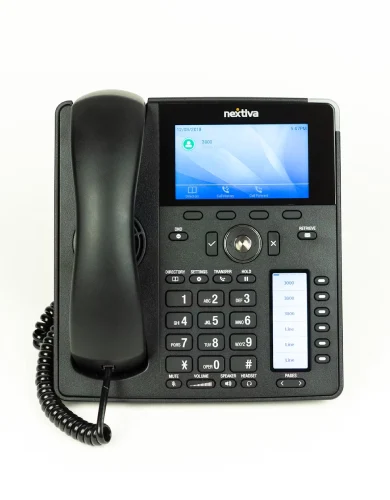Call quality for VoIP
Imagine calling a business to enquire about one of their products or services, only to be greeted by an awful virtual receptionist, loud and irritating hold music, and, when someone finally picks up, a crackling connection with echo and the noise of a busy office in the background.
Call quality on your VoIP system matters: No one wants to lose clients over a garbled line.
This article covers everything you need to know about what impacts VoIP quality, common issues, and practical steps to ensure every VoIP call your business takes or makes sounds clear and professional.
Contents
- The importance of VoIP call quality
- Key factors affecting call quality
- Common issues with VoIP call quality
- Best practices for improving VoIP call quality
The importance of VoIP call quality
Imagine a customer calling your business only to hear a crackling line, a robotic receptionist, or distracting background noise. A poor first impression like this can quickly push a potential client to look elsewhere.
With the PSTN Switch Off and full fibre rollouts luring UK companies towards business VoIP phone systems, the quality of these calls has become ever more critical.
It doesn’t matter whether the call is a customer query, a sales pitch, or a partner meeting; it will ultimately reflect on your brand. If calls are unclear or interrupted and your automated responses are poorly executed, this can lead to frustration, lost deals, and a damaged reputation.
For more information, read our guide to understanding VoIP for UK businesses.
Key factors affecting call quality
The quality of your VoIP calls can be affected at various points along the journey, from the caller’s voice being picked up by your mic to the recipient’s speakers on the other end. Let’s break down the key factors that can make or break your VoIP call quality:
1. Headset or VoIP phone
High-quality hardware is essential. A good VoIP headset or phone with noise-cancelling features and quality audio codecs will pick up and transmit your voice clearly, filtering out background noise.
Businesses don’t necessarily need premium equipment, but investing in reliable headsets and maintaining a quiet workspace can improve call clarity.
The delivery of high-quality VoIP headsets can be funded through monthly business VoIP phone system costs.
2. Local Area Network (LAN) configuration
After your voice data is converted into packets, it travels through your local area network to reach the internet.
An optimal setup transmits these data packets via Ethernet cables and routed directly to your router via well-configured network switches.
In larger organisations, advanced network solutions like SD-WAN solutions or SASE are used to prioritise VoIP data, secure it, and reduce latency, ensuring seamless call quality across locations.
In summary, ensuring your internal network has enough bandwidth, is configured with well-managed firewalls to prioritise call data, and has reliable switches and routers will significantly improve call quality.
3. Quality of broadband connection
Your broadband speed and stability are key for a high-speed, stable connection that is able to handle VoIP data alongside other business operations.
In the UK, full fibre business broadband or dedicated leased line providers are recommended for most businesses. These wired connections are less prone to latency, packet loss, and jitter, ensuring clearer, uninterrupted calls.
While convenient, wireless options like 4G/5G business broadband or business satellite broadband often have inherent drawbacks for VoIP.
They generally experience higher latency and are more susceptible to interference from environmental factors or network congestion, leading to delays, echo, or dropped calls.
4. Service Level Agreement (SLA)
Your SLA with your business VoIP provider outlines the level of performance and support you can expect, including any limits or bandwidth throttling that could affect call quality.
A robust SLA ensures priority support, reducing downtime or interruptions that might affect your business’s VoIP services and call quality.
5. End-user configuration
Call quality also depends on the person’s setup on the other end. Their device’s headset or speaker quality, broadband connection, and local network setup all impact the clarity and stability of your VoIP call.
Although this is outside your business’s control, offering alternative communication options like secure messaging or live chat provides a fallback if call quality drops.
Common issues with VoIP call quality
While any key factor can affect VoIP call quality, some issues are especially common and often traceable to specific causes. Here’s a look at the most common issues affecting VoIP calls.
Inadequate Quality of Service (QoS) Configuration
VoIP data doesn’t receive priority over less critical traffic without proper QoS configuration on your business broadband router and switches.
This lack of prioritisation often leads to congestion during high-traffic times, resulting in poor call quality, delayed audio, or packet loss, especially when your broadband and local networks are nearing capacity.
Proper QoS settings through network monitoring tools can help ensure VoIP traffic flows smoothly, even when other data-heavy tasks are in progress.
Limited or inconsistent bandwidth
Many businesses operate with broadband plans that lack the bandwidth to support VoIP and other network activities, especially those relying on basic broadband packages like ADSL or SoGEA.
Insufficient bandwidth can cause high latency, jitter, and packet loss, especially if multiple devices and applications run simultaneously. Upgrading to a high-capacity, stable business broadband deals can alleviate these issues.
For more information visit our guide to managing VoIP in high traffic.
Outdated or low-quality networking hardware
Too many businesses continue to use older or consumer-grade routers, switches, and modems that can impact VoIP performance.
Business-grade routers with VoIP support and advanced features, like automatic traffic prioritisation and robust processing power, are necessary for maintaining call quality. Outdated hardware is also vulnerable to cybersecurity threats and inefficient data handling.
VoIP over WiFi
Businesses that rely on WiFi (even with mesh networks) often struggle to handle VoIP traffic efficiently, as wireless networks must share bandwidth and don’t have dedicated lines. They are also more susceptible to interference, leading to unstable connections.
For businesses with significant VoIP demands, a well-structured network with ample Ethernet cabling and organised network switching helps improve stability and minimise data loss.
Note: VoIP over 5G private networks may offer the performance needed for a wireless VoIP network, but they are expensive to implement.
Improper firewall or security configuration
Firewalls and security protocols that block or interfere with VoIP traffic can cause call drops, delays, and degraded audio quality.
Firewalls should be configured to allow VoIP traffic to pass freely while maintaining strong broadband cybersecurity. Common issues arise from unoptimised firewall settings, lack of SIP ALG (Session Initiation Protocol Application Layer Gateway), or blocked VoIP-specific ports.
Find out more in our full guide to VoIP security.
Best practices for improving VoIP call quality
Here is a summary of best practices to ensure high VoIP call quality for your business:
| Best practice | Description |
|---|---|
| High-quality hardware | Invest in reliable VoIP phones and headsets with noise-cancelling and high-definition codecs for clear audio quality. |
| Optimised LAN configuration | Use Ethernet connections where possible and configure network switches to prioritise VoIP traffic, especially in larger networks. |
| Advanced network solutions | Implement SD-WAN or SASE for efficient data routing, enhanced security, and prioritisation of VoIP calls across locations. |
| Quality of Service (QoS) settings | Configure QoS settings on routers and switches to prioritise VoIP data, minimising delays and packet loss. |
| Fast broadband connection | Use a stable, high-speed broadband connection, ideally full fibre or a leased line, to handle VoIP alongside other activities. See here for an analysis of minimum broadband requirements. |
| Comprehensive SLA | Ensure your SLA with your broadband provider guarantees minimum performance levels, prioritised support, and no throttling. |

